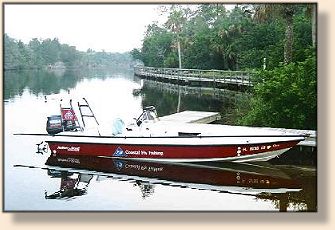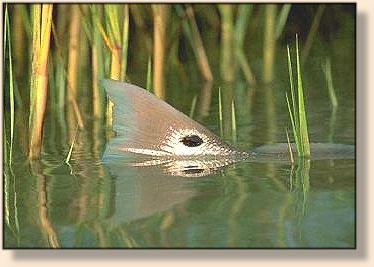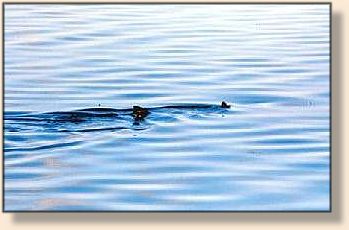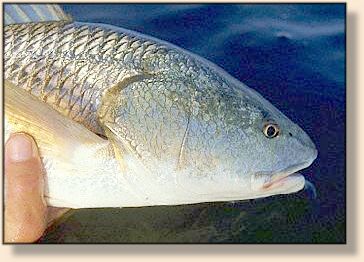I love this time of year. It is hot and humid. Shore breezes are calm
but pick up in the late afternoon. The sun is high and you can look
right into the water at the bottom. This is a time when the days are
longer allowing for an early start. On the water by 6 am and back
by noon, or a late afternoon starting at 4pm and back about 9pm.
The weather gets down right nasty at about 1:30 pm but the rain
and thunder are usually gone by 3:30 pm. Like clock work, you
can depend on this schedule until late September. Early morning
is the best time of day. The water is flat like glass and the air is cool.
 In Mosquito Lagoon the reds are tailing at first light and then again
at dusk. The lagoon is the second largest estuary in the United States,
and home to the world's largest redfish and spotted sea trout. Sight
fishing for trophy fish is part art and part science. The science is in
knowing what fly to cast and then how to retrieve and hook up.
The art is in finding the fish because they travel in schools. You
look for a tail or a push.
In Mosquito Lagoon the reds are tailing at first light and then again
at dusk. The lagoon is the second largest estuary in the United States,
and home to the world's largest redfish and spotted sea trout. Sight
fishing for trophy fish is part art and part science. The science is in
knowing what fly to cast and then how to retrieve and hook up.
The art is in finding the fish because they travel in schools. You
look for a tail or a push.
 You'll see a tail edging the tall grass, or a group pushing ahead with tails
or dorsal fins just cutting the surface. I've poled anglers in 16 inches of
water for more than 2 miles, seeing tail-pushes for hours. It is a magnificent
sight. The trout fishing is steady throughout the day. Large gator trout
make unmistakable pushes just below the water and above the grass line.
They look like submarines parading through the shallows. An occasional
alligator can be seen too, lurking in the shallows. I have never seen
alligators bother anglers but waders should be careful. With the sun
up high waters here are gin clear. From the poling platform, you can
easily see one hundred yards in any direction. Anglers can see a push
or a blowout within 20 yards of the boat and it makes for a team effort
when sight fishing. You can really feel the excitement once the school
is spotted.
You'll see a tail edging the tall grass, or a group pushing ahead with tails
or dorsal fins just cutting the surface. I've poled anglers in 16 inches of
water for more than 2 miles, seeing tail-pushes for hours. It is a magnificent
sight. The trout fishing is steady throughout the day. Large gator trout
make unmistakable pushes just below the water and above the grass line.
They look like submarines parading through the shallows. An occasional
alligator can be seen too, lurking in the shallows. I have never seen
alligators bother anglers but waders should be careful. With the sun
up high waters here are gin clear. From the poling platform, you can
easily see one hundred yards in any direction. Anglers can see a push
or a blowout within 20 yards of the boat and it makes for a team effort
when sight fishing. You can really feel the excitement once the school
is spotted.
I had seen a large pod of redfish. I kept poling in a direction that would
put us on a collision course with their movement. Just when I would start
closing the school would change direction. I followed three schools for
almost 4 miles. I stopped for a short break to drink some water. With
the boat stopped and settled into the water, I took a long drink of water.
At the same time I looked around. Two pods had been moving in our
direction but I was sure the boat would spook them. So I was concentrating
on intersecting a large school moving above Tiger Shoals. I wanted to get
my anglers within a 50 to 60 foot cast. This would allow us time for a
second cast.
It was 9:30 and I had been poling since just before sunrise, when Rob said,
"What's that? I looked down and to my surprise there was a pod of redfish.
Tails out of the water they just cruised along side my boat. This is not unusual.
I've seen monster reds follow along side the boat and have my anglers just
marvel at their beauty.
"What should I do?" asked Rob.
"Just watch them, they won't take a fly this close," came my reply.
"Wow! They are beautiful. How big do you figure they are?"
"Probably about 5 to 7 pounds."

Their tails just waddled above the surface. A pod of 20 fish just cruised
along. They were close enough to say hello and probably came up from
behind the boat.
"This is like hunting, Captain?" Rob asked.
"Yes," I said, "that's exactly what we are doing - hunting and sighting for redfish
and trout. We need to get close enough for a cast without spooking the fish.
We will wait until they are about 30 feet in front and then I'll turn the bow
away from them. Get ready to cast."
I poled us into position. And then it happened. Another pod and then a
bigger school appeared out of nowhere. We were located just off a flat
in about 3 feet of water. Between the boat and the flat were about 300
redfish, a pod of skates and thousands of baitfish. We stayed in that one
spot for the next two hours and my anglers were delighted by the action
of these reds that were just as happy to get hooked up and released, to
do it all over again.
 We were in the right place at the right time. We caught about 25 reds and
decided to move to a new location. I took my anglers to my favorite flat
that was shielded on three sides from a hard blowing east wind. Once in
the back of the flat you could make small adjustments as you drifted out.
This flat is known for its monster trout. I recalled earlier in the morning
as Rob talked about the revival of the trout fishery on the west coast of
Florida. He said that the trout were big and averaged between 3 and
5 pounds. Boy was he in for a surprise.
We were in the right place at the right time. We caught about 25 reds and
decided to move to a new location. I took my anglers to my favorite flat
that was shielded on three sides from a hard blowing east wind. Once in
the back of the flat you could make small adjustments as you drifted out.
This flat is known for its monster trout. I recalled earlier in the morning
as Rob talked about the revival of the trout fishery on the west coast of
Florida. He said that the trout were big and averaged between 3 and
5 pounds. Boy was he in for a surprise.
Just as I figured this flat was active with reds and trout. We hooked up
some more reds and a couple of small trout. As I rounded a point, I
motioned to Rob that there would be big pushes near a dead tree on the
waters edge. I said, "Rob, do not wait for my signal. If you see a push
cast to the direction of the movement and lead by at least 10 feet."
Just as I said this a huge push came off the bank and Rob shot a cast out
50 feet. As the push neared the Bucktail fly I said, "tug." And in that instant,
Rob's rod bent in half and we were in for a 20 minute battle of a nice 6.5
pound, 29 inch gator trout.
When you fish these parts everyday you learn a lot about the environment
and the fishery. This is a great time of year to be fishing. Share the outdoors
with a friend, neighbor, or someone you know will enjoy and appreciate
the experience.
Catch & Release: Protect the Species. ~ "Doug"
About Doug:
Capt. Doug Sinclair has relocated from New Smyrna Beach, Florida to
Grantsboro, NC. He specializes in fly-fishing and light tackle charters.
Doug charters the Coastal Carolina area of New Bern or Oriental.
Catch him on the web at
www.flyfishacademy.net or call him at (252) 745-3500.
Doug is also a Sponsor here on FAOL.
|

